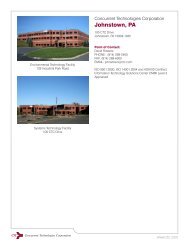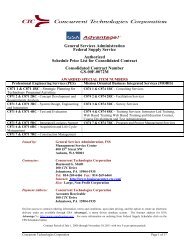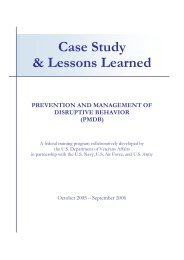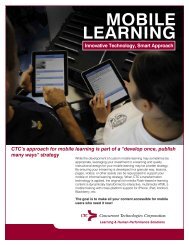Information Security Warfare Systems - CTC Bremerton Instructional ...
Information Security Warfare Systems - CTC Bremerton Instructional ...
Information Security Warfare Systems - CTC Bremerton Instructional ...
Create successful ePaper yourself
Turn your PDF publications into a flip-book with our unique Google optimized e-Paper software.
ADL SCORM 2004 Demonstration: ISWS Course Conversion Lessons Learned<br />
2. Content examples are an efficient tool for learning and assimilating SCORM, particularly<br />
the more complicated aspects like sequencing. They can also serve to jump-start the<br />
development process by providing source code.<br />
Before beginning the project, the project team reviewed the SCORM 2004 Photoshop Examples<br />
Version 1.0 available on ADLNet and another content example demonstrated at PlugFest 8. The<br />
examples demonstrated the different possibilities for sequencing and provided code that could be<br />
dissected for greater understanding of how sequencing works. Viewing and discussing the<br />
examples also led to a deeper understanding of the ways SCORM can be used. For instance, the<br />
team noted that any content that didn’t need to communicate with the LMS defaulted to being an<br />
Asset, resulting in fewer SCOs.<br />
Working through the content examples as a group prompted solid discussion about the content<br />
organization of the ISWS course, resulting in the definition of basic sequencing rules and an<br />
activity tree. The content examples also established a basis for the design of the manifest.<br />
The creation of more content examples and sequencing models geared towards the development<br />
community is anticipated. As a library of models and examples emerges, and developers find it<br />
easy to adapt a wide variety of existing code to their own needs, new applications of SCORM<br />
2004 will proliferate in the development community.<br />
3. Determining the course structure is a collaborative process that starts with logical rules<br />
and gradually incorporates the technical requirements related to SCORM.<br />
Drawing from their previous design and development experience and the experience with the<br />
SCORM 2004 content examples, the project team developed the ISWS course in a series of<br />
iterations. Solid instructional design was the first consideration for the organization of the<br />
content. The next consideration was how the learner would experience that content, dictating<br />
how the pieces of content would interact with each other. At this point, it was necessary to start<br />
examining the available sequencing options and defining SCOs and Assets.<br />
In essence, the activity tree became a storyboard for sequencing. At the beginning of the project,<br />
the team thought two versions of the course activity tree should be developed. One would<br />
contain the logical structure and rules and would be the activity tree the project team would agree<br />
on and work from. It would also be used to communicate with clients and stakeholders and<br />
would be included in design documentation. The second version of the activity tree would take<br />
the logical rules and translate them into the technical rules and structure required by SCORM. It<br />
was thought that this activity tree would be used primarily for development, but could also be<br />
included in design documentation, depending on the requirements of the project.<br />
As development progressed, however, the team realized that the manifest itself really became the<br />
documentation, and reference was rarely made to the technical activity tree. So while the logical<br />
activity tree still has value, one that defines all the technical rules may not be necessary.<br />
Nevertheless, a technical activity tree is a useful learning tool for developers and has therefore<br />
been included as a supplement to this document.<br />
<strong>CTC</strong> <strong>Bremerton</strong>, May 14, 2004 4












